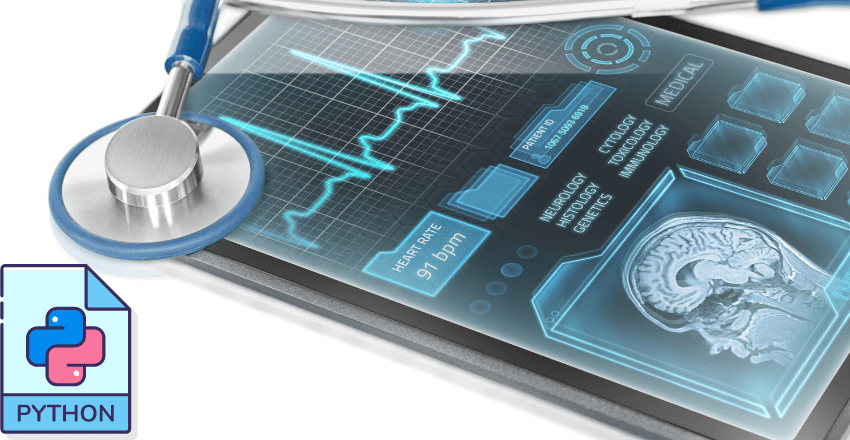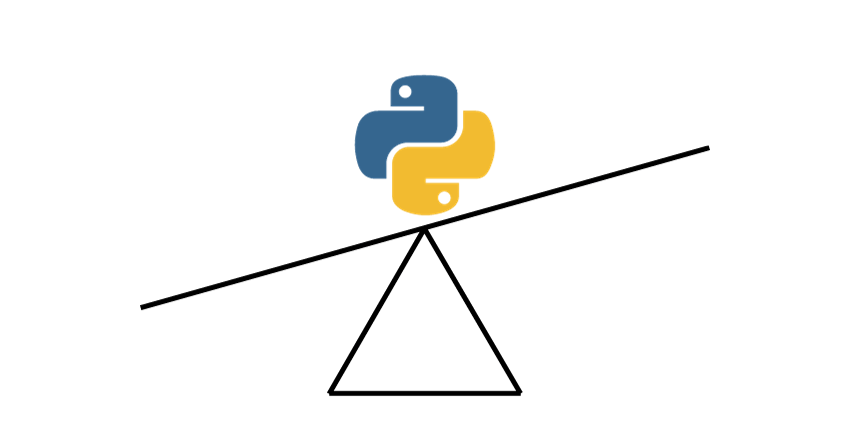 In recent years, healthcare innovations have been revolutionized by data-driven technology, and Python has emerged as a powerful tool for building effective healthcare solutions. Python healthcare solutions are at the forefront of data-driven healthcare, enabling healthcare providers to analyze vast amounts of data quickly and efficiently, leading to improved patient outcomes.
In recent years, healthcare innovations have been revolutionized by data-driven technology, and Python has emerged as a powerful tool for building effective healthcare solutions. Python healthcare solutions are at the forefront of data-driven healthcare, enabling healthcare providers to analyze vast amounts of data quickly and efficiently, leading to improved patient outcomes.
Building Healthcare Solutions with Python
Python has become an essential tool for building healthcare solutions due to its simplicity, flexibility, and readability. Healthcare developers can harness Python’s power to create data-driven applications that can help doctors and other medical professionals make better decisions.
One popular Python framework used in healthcare development is Django. With Django, developers can build scalable and secure healthcare applications faster. It offers a user-friendly admin panel for managing the backend, as well as built-in security features to protect sensitive patient information.
| Python | Other Languages |
|---|---|
| Python has a concise and readable syntax that makes it easy to learn and use, even for beginners. | Other languages such as Java or C++ have complex syntax and require more code to achieve the same functionality as Python. |
| Python has a vast standard library that includes many pre-built modules for data processing and visualization. | Other languages lack the comprehensive and pre-built modules that Python offers. |
Another popular Python framework is Flask, a lightweight and scalable web framework that is suitable for developing microservices-based healthcare applications. Developers can use Flask to build RESTful APIs that can handle HTTP requests and responses.
Python also offers powerful data analysis and machine learning libraries like NumPy, pandas, and scikit-learn. Developers can use these libraries to extract insights from healthcare data and build predictive models that can help diagnose diseases.
One example of Python in healthcare is the use of telemedicine solutions during the COVID-19 pandemic. Python-powered telemedicine applications have enabled remote medical consultations, allowing doctors to monitor patients’ conditions and provide treatment recommendations. Another example is the development of predictive analytics models that can identify patients at high risk of developing chronic diseases, enabling doctors to provide timely preventative care.
Overall, Python’s flexibility and readability make it an ideal language for building healthcare solutions. With the help of Python frameworks and libraries, developers can create efficient and secure healthcare applications that can improve patient outcomes.
Leveraging Python for Medical Solutions

Python’s flexibility and versatility make it a valuable tool for developing medical solutions across a range of healthcare settings. Its simplicity and ease of use allow developers to build custom applications quickly, while its powerful libraries enable data processing and analysis with ease.
One area where Python is particularly effective is in medical imaging. Python’s renowned libraries, such as OpenCV and SimpleITK, offer a comprehensive suite of tools for image processing, allowing developers to create sophisticated solutions for diagnosing and treating various medical conditions.
| OpenCV | SimpleITK |
|---|---|
| import cv2 img = cv2.imread(‘image.jpg’,0) cv2.imshow(‘image’,img) | import SimpleITK as sitk image = sitk.ReadImage(‘image.nii.gz’) sitk.Show(image) |
In addition to medical imaging, Python can also be leveraged to develop predictive analytics and personalized medicine solutions. Python’s machine learning libraries, such as TensorFlow and Scikit-learn, enable developers to create predictive models that can forecast patient outcomes and recommend personalized treatments based on individual patient data.
Another application of Python in healthcare is in the development of telemedicine solutions. Python’s web frameworks, such as Django and Flask, are ideal for building secure, scalable telemedicine applications that connect patients and doctors remotely.
Overall, Python’s flexibility and data-driven approach make it an ideal choice for developing medical solutions that can enhance patient care and improve healthcare outcomes.
Python vs. Other Languages in Healthcare Development
Python is an increasingly popular language for healthcare development due to its simple syntax, ease of use, and wide range of libraries and frameworks. Compared to other languages commonly used in healthcare development, such as Java and C++, Python offers several advantages.
For example, Python’s concise and readable code makes it easier to develop and maintain healthcare solutions. Additionally, Python’s dynamic typing allows for faster development time and easier debugging.
Let’s take a look at a code example comparing Python and Java:
| Python | Java |
|---|---|
| |
As we can see, the Python code is much simpler and more concise than the equivalent Java code. This makes it easier to write, understand, and maintain healthcare solutions in Python.
Furthermore, when it comes to creating web-based healthcare solutions, Python frameworks such as Django and Flask offer a range of advantages over other languages. For example, Django’s built-in admin interface makes it easy to manage and monitor healthcare data, while Flask’s simple and lightweight architecture makes it ideal for smaller-scale applications.
Here’s an example of comparing the syntax of Django and Ruby on Rails:
| Django | Ruby on Rails |
|---|---|
return HttpResponse(“Hello, world!”) | |
While both frameworks are powerful and widely used, Django’s syntax is generally considered to be more readable and easier to write than Ruby on Rails. This makes it a popular choice for healthcare web development.
Python offers significant advantages over other languages in healthcare development, including concise and readable code, dynamic typing, and powerful frameworks. As the healthcare industry continues to rely more heavily on technology, Python’s capabilities will undoubtedly become increasingly valuable.
Data-Driven Healthcare Solutions with Python
Data-driven technology is transforming the healthcare industry, and Python healthcare solutions provide a powerful tool for leveraging large amounts of healthcare data. Python’s flexibility and ease of use make it an ideal language for developing data-driven healthcare solutions that can improve patient outcomes.
One area where Python excels is in the development of predictive analytics tools that can analyze patient data to identify trends and patterns. These tools can be used to create personalized treatment plans that take into account a patient’s unique medical history and health needs.
Python can also be used to develop telemedicine solutions that enable remote patient monitoring and virtual consultations. These solutions have become increasingly important in the wake of the COVID-19 pandemic, as healthcare providers seek to reduce the risk of virus transmission while still providing high-quality care.
To illustrate the power of Python in developing data-driven healthcare solutions, consider the following code example:
#importing necessary modules
import pandas as pd
import numpy as np
import matplotlib.pyplot as plt
#reading data from CSV file
patient_data = pd.read_csv('patient_data.csv')#cleaning data
patient_data = patient_data.dropna()
patient_data = patient_data[patient_data['age']<=75]
patient_data = patient_data[patient_data['diabetes']=='Yes']
#analyzing data
mean_blood_sugar = np.mean(patient_data['blood_sugar'])
mean_blood_pressure = np.mean(patient_data['blood_pressure'])
num_patients = len(patient_data)
#displaying results
print('Mean blood sugar:', mean_blood_sugar)
print('Mean blood pressure:', mean_blood_pressure)
print('Number of patients analyzed:', num_patients)
#creating visualization
plt.scatter(patient_data['blood_sugar'], patient_data['blood_pressure'])
plt.xlabel('Blood Sugar')
plt.ylabel('Blood Pressure')
plt.title('Blood Sugar vs. Blood Pressure in Diabetic Patients')
plt.show()This code demonstrates how Python can be used to analyze patient data and create visualizations that help healthcare providers identify trends and patterns. By leveraging large amounts of healthcare data, Python healthcare solutions can help providers make more informed decisions and deliver better patient care.
Python Frameworks for Healthcare Solutions

Python offers a range of frameworks that are specifically designed for healthcare solutions, making it easier and more efficient to develop healthcare applications. Here are some of the most popular Python frameworks used in the healthcare industry:
| Framework | Description |
|---|---|
| Django | Django is a high-level Python web framework that is ideal for developing complex healthcare applications. It provides a range of tools and features for building scalable and secure applications, including authentication, template rendering, and admin interfaces. |
| Flask | Flask is a lightweight Python web framework that is well-suited for developing simple healthcare applications. It is easy to use and flexible, providing a range of extensions that can be used to add functionality to your application. |
| Pyramid | Pyramid is a Python web framework that is similar to Flask in terms of its simplicity and flexibility. It is designed for building large-scale applications and provides a range of features for handling complex healthcare data. |
Each framework has its own strengths and weaknesses, and the choice of framework will depend on the specific requirements of your healthcare application. For example, if you need to build a complex healthcare application with a lot of features, Django may be the best choice. On the other hand, if you need to build a simple application quickly, Flask may be a better option.
Let’s take a look at a code example using the Django framework:
# views.py
from django.shortcuts import render
def patient_detail(request, patient_id):
patient = Patient.objects.get(id=patient_id)
return render(request, 'patients/detail.html', {'patient': patient})The above code defines a view function using the Django framework. When a user requests the patient detail page, the function retrieves the patient object from the database and renders the patient detail template with the patient data.
Now, let’s compare the Django framework with the Flask framework using a code example:
# app.py (using Flask)
from flask import Flask, render_template, request
app = Flask(__name__)
@app.route('/patient/')
def patient_detail(patient_id):
patient = get_patient(patient_id)
return render_template('patient_detail.html', patient=patient)The above code defines a route function using the Flask framework. When a user requests the patient detail page, the function retrieves the patient object from the database and renders the patient detail template with the patient data.
As you can see, both Django and Flask provide similar functionality for handling requests and rendering templates. The main difference lies in the complexity of the frameworks and the level of customization they provide.
Python frameworks provide an efficient and effective way to develop healthcare solutions. Whether you choose Django, Flask, Pyramid, or another framework, Python’s versatility and power make it an ideal choice for building innovative healthcare applications.
Maximizing Efficiency with Python Healthcare Solutions
Python healthcare solutions are a powerful tool for maximizing efficiency in healthcare settings. By automating tasks and streamlining processes, healthcare providers can save time and resources while improving patient care. Here are some examples of how Python can be used to achieve these goals:
Automating Routine Tasks
Python’s scripting capabilities make it an ideal choice for automating routine tasks such as data entry and report generation. By writing scripts that perform these tasks automatically, healthcare providers can save time and reduce the risk of errors caused by manual data entry. For example, a Python script could be used to automatically generate reports on patient outcomes, allowing healthcare providers to quickly identify areas where improvements could be made.
Streamlining Data Analysis
Python’s data analysis libraries, such as Pandas and Numpy, allow healthcare providers to quickly and accurately analyze large amounts of data. By streamlining the data analysis process, healthcare providers can gain insights into patient outcomes and treatment effectiveness more quickly and efficiently. For example, a Python script could be used to analyze patient data and identify patterns and trends that could inform treatment decisions.
Improving Communication
Python can be used to develop telemedicine solutions that allow healthcare providers to communicate with patients remotely. By leveraging Python’s web development frameworks, such as Django and Flask, healthcare providers can develop secure, user-friendly telemedicine platforms that allow for remote consultations and monitoring. This can be particularly useful for patients who live in remote areas or who have mobility issues.
Optimizing Clinical Workflows
Python can be used to develop applications that optimize clinical workflows, such as appointment scheduling and medication management. By streamlining these workflows, healthcare providers can improve patient care and reduce the risk of errors caused by miscommunications or scheduling conflicts. For example, a Python application could be used to automatically schedule appointments based on a patient’s availability and the availability of healthcare providers.
Python healthcare solutions offer a wide range of benefits for healthcare providers looking to maximize efficiency and improve patient care. By automating routine tasks, streamlining data analysis, improving communication, and optimizing clinical workflows, healthcare providers can save time and resources while providing better care to their patients.
Enhancing Patient Care with Python
Python healthcare solutions have the potential to greatly enhance patient care through predictive analytics, personalized medicine, and telemedicine solutions.
Predictive Analytics
Predictive analytics is a method of using data, statistical algorithms, and machine learning techniques to identify the likelihood of future outcomes based on historical data. Python offers a range of libraries for data analysis, including pandas and scikit-learn, which make it an ideal language for predictive analytics in healthcare.
For example, a healthcare provider could use predictive analytics to identify patients who are at risk of developing a certain condition, such as diabetes or heart disease. By analyzing a patient’s medical history and lifestyle factors, predictive analytics algorithms can identify patterns and markers that indicate a higher risk of developing the condition. This information can be used to develop targeted prevention and treatment plans for at-risk patients.
Personalized Medicine
Personalized medicine is an approach that uses a patient’s individual genetic, environmental, and lifestyle factors to tailor medical treatments and interventions. Python is a powerful language for managing and analyzing large amounts of patient data, making it ideal for developing personalized medicine solutions.
One example of a Python-based personalized medicine solution is the Tumor Purity and Heterogeneity Estimation (Thor) tool, developed by researchers at the University of California, San Francisco. Thor uses Python libraries to analyze DNA sequencing data from tumors, providing clinicians with a more accurate assessment of tumor purity and heterogeneity to guide treatment decisions.
Telemedicine Solutions
Telemedicine refers to the use of technology to provide healthcare services remotely. Python is well-suited to developing telemedicine solutions, with its ability to handle large amounts of data and support for real-time communication protocols.
One example of a Python-based telemedicine solution is the OpenVINO toolkit, developed by Intel. OpenVINO uses computer vision and deep learning algorithms to enable real-time analysis of patient data, allowing healthcare providers to remotely monitor patients and provide teleconsultations.
Overall, Python healthcare solutions have the potential to greatly enhance patient care through predictive analytics, personalized medicine, and telemedicine solutions. By leveraging the power of data-driven technology, healthcare providers can improve patient outcomes and deliver more efficient and effective care.
Implementing Python Healthcare Solutions: Best Practices

Implementing Python healthcare solutions requires careful planning and adherence to best practices to ensure successful outcomes. Here are some tips and guidelines to help you get started:
Define Clear Objectives
Before embarking on any Python healthcare project, it is vital to have a clear understanding of the objectives you wish to achieve. Clearly define your goals and communicate them to your team to ensure everyone is on the same page. This will help you stay focused and avoid scope creep.
Choose the Right Framework
Choosing the right framework is essential for developing efficient and effective Python healthcare solutions. Consider factors such as ease of use, scalability, and compatibility with other systems. Popular Python frameworks for healthcare include Django, Flask, and Pyramid.
| Framework | Pros | Cons |
|---|---|---|
| Django | Robust and scalable, includes built-in admin interface | Can be complex for small projects |
| Flask | Lightweight and flexible, easy to learn | May require additional packages for certain functionality |
| Pyramid | Highly customizable, supports multiple databases | Steep learning curve |
Use Best Coding Practices
When developing Python healthcare solutions, it is essential to follow best coding practices to ensure your code is clean, maintainable, and efficient. Use naming conventions that are clear and descriptive, avoid hardcoding values, and comment your code thoroughly. Consider using a code linter such as Pylint to check for errors and ensure consistency.
Ensure Data Security and Privacy
Healthcare data is highly sensitive and must be protected from unauthorized access and theft. When implementing Python healthcare solutions, ensure that data security and privacy are top priorities. Consider implementing encryption, access controls, and regular data backups. It is also essential to comply with relevant regulations, such as HIPAA in the United States.
Test and Iterate
Thoroughly test your Python healthcare solutions before deployment to ensure they function as intended and meet your objectives. Use automated testing tools such as pytest to streamline the testing process. Once deployed, monitor your solutions closely and gather feedback from users to identify areas for improvement. Iterate as necessary to ensure your solutions continue to meet the evolving needs of your organization and patients.
By following these best practices, you can ensure that your Python healthcare solutions are efficient, effective, and secure. Keep up-to-date with emerging trends and advancements in the field to stay ahead of the curve and make the most of this innovative technology.
Conclusion
Python healthcare solutions are revolutionizing the healthcare industry with their innovative technology and data-driven approach. From building effective healthcare solutions to leveraging Python for medical solutions, Python is proving to be a versatile language with immense potential for improving patient care.
FAQ

Q: What are Python healthcare solutions?
A: Python healthcare solutions refer to the use of the Python programming language to develop innovative and data-driven solutions in the healthcare industry. These solutions leverage Python’s versatility and powerful frameworks to improve patient care and optimize healthcare processes.
Q: How can Python be used to build healthcare solutions?
A: Python can be used to build healthcare solutions by providing a flexible and robust platform for developing software applications. With its extensive library ecosystem and support for data analysis and visualization, Python enables developers to create effective and efficient healthcare solutions.
Q: What are some of the ways Python is leveraged in medical solutions?
A: Python is leveraged in medical solutions in various ways, including developing electronic health record systems, creating machine learning algorithms for disease diagnosis and prediction, and building telemedicine platforms for remote patient care.
Q: How does Python compare to other languages in healthcare development?
A: Python offers several advantages over other languages commonly used in healthcare development. It has a clean and easy-to-read syntax, extensive community support, and powerful frameworks like Django and Flask that streamline development processes.
Q: How can Python be used for data-driven healthcare solutions?
A: Python is well-suited for data-driven healthcare solutions due to its robust data processing and analysis capabilities. With Python, large amounts of healthcare data can be efficiently managed and analyzed to derive valuable insights and support evidence-based decision-making.
Q: What are some popular Python frameworks for healthcare solutions?
A: Some popular Python frameworks for healthcare solutions include Django, Flask, and Pyramid. These frameworks provide a solid foundation for building secure and scalable healthcare applications.
Q: How can Python healthcare solutions maximize efficiency in healthcare settings?
A: Python healthcare solutions can maximize efficiency in healthcare settings by automating routine tasks, streamlining data management processes, and integrating disparate systems. This allows healthcare professionals to focus more on patient care and improves overall operational efficiency.
Q: In what ways can Python healthcare solutions enhance patient care?
A: Python healthcare solutions can enhance patient care by enabling predictive analytics to identify potential health risks, facilitating personalized medicine based on individual patient data, and supporting telemedicine solutions for remote consultations and monitoring.
Q: What are some best practices for implementing Python healthcare solutions?
A: When implementing Python healthcare solutions, it is important to follow best practices such as modular code design, adopting secure coding practices, ensuring data privacy and security, and conducting thorough testing and validation. Additionally, considering scalability and usability factors will contribute to successful implementation.
Lydia is a seasoned technical author, well-versed in the intricacies of software development and a dedicated practitioner of Python. With a career spanning 16 years, Lydia has made significant contributions as a programmer and scrum master at renowned companies such as Thompsons, Deloit, and The GAP, where they have been instrumental in delivering successful projects.
A proud alumnus of Duke University, Lydia pursued a degree in Computer Science, solidifying their academic foundation. At Duke, they gained a comprehensive understanding of computer systems, algorithms, and programming languages, which paved the way for their career in the ever-evolving field of software development.
As a technical author, Lydia remains committed to fostering knowledge sharing and promoting the growth of the computer science community. Their dedication to Python development, coupled with their expertise as a programmer and scrum master, positions them as a trusted source of guidance and insight. Through their publications and engagements, Lydia continues to inspire and empower fellow technologists, leaving an indelible mark on the world of scientific computer science.


![15 Most Contributed Python Projects on GitHub [Stats]](https://hirepythondeveloper.com/wp-content/uploads/2024/03/15-Most-Contributed-Python-Projects-on-GitHub-Stats-1-150x150.png)




